Decoupling the Monitoring of Solar Water Heaters and their Usage Profiles
Abstract
:1. Introduction
2. Material and Methods
2.1. The Study Area
2.2. Solar Water Heater Outdoor Test Rig
3. Results and Discussion
3.1. Overall System Behaviour over Four Days
3.2. System Behaviour on a Clear and Cloudy Day
3.3. Effect of Ambient Temperature on Solar Water Heater Systems
3.4. Sensitivity Analysis of Hot Water Production
3.5. Cost and Payback Period
4. Conclusions
Author Contributions
Funding
Institutional Review Board Statement
Informed Consent Statement
Data Availability Statement
Acknowledgments
Conflicts of Interest
Abbreviation
| Nomenclature | |
| Abbreviation | |
| SWH | Solar water heaters |
| GHI | Global horizontal irradiation |
| HP | High-pressure |
| LP | Low-pressure |
| DAC | Data acquisition and control |
| SCADA | Supervisory control and data acquisition |
| FP | Flat Plate |
| ET | Evacuated Tube |
| Symbols | |
| Heat gained by the collector (J) | |
| Area of the collector (m2) | |
| Incident irradiance on the collector (W/m2) | |
| Water temperature out of the collector into the storage tank (°C) | |
| Water from the mains into the collector (°C) | |
| Area of the geyser (m2) | |
| Heat removal factor of the collector | |
| Absorbance transmittance product | |
| Time (s) | |
| Flow rate of water inside the collector (kg/h) | |
| Specific heat capacity of water (J/kg/°C) | |
| Total heat transfer coefficient of the collector (W/m2.°C) | |
| Systems efficiency (%) | |
| Average electricity use per household (kWh/day) | |
| Daily water usage (L) | |
| Electricity cost (kWh) | |
References
- Sims, R. Renewables for Heating and Cooling: Untapped Potential; International Energy Agency: Paris, France, 2007; pp. 1–210. [Google Scholar]
- Peter, C.; Marilyn, S. Technology Roadmap: Solar Heating and Cooling; International Energy Agency: Paris, France, 2012; pp. 1–50. [Google Scholar] [CrossRef]
- Buckley, A. Policy Brief: Solar Water Heating Technologies; Center for Renewable & Sustainable Energy Studies: Stellenbosch, South Africa, 2019; pp. 1–35. [Google Scholar]
- Ali-Waeli, A.H.A.; Sopian, K.; Kazem, H.A.; Chaichan, M.T. Photovoltaic/Thermal (PV/T) Systems: A review. Int. J. Comput. Appl. Sci. 2017, 2, 62–67. [Google Scholar] [CrossRef]
- Hirbodi, K.; Enjavi-Arsanjani, M.; Yaghoubi, M. Techno-economic assessment and environmental impact of concentrating solar power plants in Iran. Renew. Sustain. Energy Rev. 2020, 120, 109642. [Google Scholar] [CrossRef]
- Lim, Y.S.; Lo, C.K.; Kee, S.Y.; Ewe, H.T.; Faidz, A.R. Design and evaluation of passive concentrator and reflector systems for bifacial solar panel on a highly cloudy region—A case study in Malaysia. Renew. Energy 2014, 63, 415–425. [Google Scholar] [CrossRef]
- Oosthuizen, D.; Goosen, N.J.; Hess, S. Solar thermal process heat in fishmeal production: Prospects for two South African fishmeal factories. J. Clean. Prod. 2020, 253, 119818. [Google Scholar] [CrossRef]
- Endale, A. Analysis of status, potential and economic signi fi cance of solar water heating system in Ethiopia. Renew. Energy 2020, 132, 1167–1176. [Google Scholar] [CrossRef]
- Roberts, D.E.; Forbes, A. An analytical expression for the instantaneous efficiency of a flat plate solar water heater and the influence of absorber plate absorptance and emittance. Sol. Energy 2012, 86, 1416–1427. [Google Scholar] [CrossRef]
- Wei, L.; Yuan, D.; Tang, D.; Wu, B. A study on a flat-plate type of solar heat collector with an integrated heat pipe. Sol. Energy 2013, 97, 19–25. [Google Scholar] [CrossRef]
- Sathyamurthy, R.; El-Agouz, S.A.; Nagarajan, P.K.; Subramani, J.; Arunkumar, T.; Mageshbabu, D.; Madhu, B.; Bharathwaaj, R.; Prakash, N. A review of integrating solar collectors to solar still. Renew. Sustain. Energy Rev. 2017, 77, 1069–1097. [Google Scholar] [CrossRef]
- Abdullah, A.L.; Misha, S.; Tamaldin, N.; Rosli, M.A.M.; Sachit, F.A. Photovoltaic thermal/solar (PVT) collector (PVT) system based on fluid absorber design: A review. J. Adv. Res. Fluid Mech. Therm. Sci. 2018, 48, 196–208. [Google Scholar]
- Duffie, J.A.; Beckman, W.A.; Blair, N. Solar Engineering of Thermal Processes, Photovoltaics and Wind, 5th ed.; John Wiley & Sons, Inc.: Hoboken, NJ, USA, 2020; pp. 1–919. [Google Scholar] [CrossRef]
- Tanase, A.; Cheng, S.C.; Groeneveld, D.C.; Shan, J.Q. Diameter effect on critical heat flux. Nucl. Eng. Des. 2009, 239, 289–294. [Google Scholar] [CrossRef]
- Salgado-Conrado, L.; Lopez-Montelongo, A. Barriers and solutions of solar water heaters in Mexican household. Sol. Energy 2019, 188, 831–838. [Google Scholar] [CrossRef]
- Ratshomo, K.; Nembahe, R. 2018 South African Energy Sector Report. 2018. Available online: http://www.energy.gov.za (accessed on 7 April 2021).
- Thobejane, J.S.; Masekameni, D.M.; Rathebe, P.C.; Mgwambani, S.L. The effectiveness of solar water heating geysers in South Africa: A Review. In Proceedings of the 2019 International Conference on the Domestic Use of Energy (DUE), Wellington, South Africa, 25–27 March 2019; pp. 59–62. [Google Scholar]
- Netshiozwi, E.E. Causes of failure of the South African solar water heating programme and the forgone social benefits. Rev. Soc. Sci. 2019, 4, 1–15. [Google Scholar] [CrossRef]
- Saint Akadiri, S.; Bekun, F.V.; Taheri, E.; Akadiri, A.C. Carbon emissions, energy consumption and economic growth: A causality evidence. Int. J. Energy Technol. Policy 2019, 15, 320–336. [Google Scholar] [CrossRef]
- Department of Environmental Affairs and Tourism, a National Climate Change Response Strategy. 2004. Available online: http://unfccc.int/files/meetings/seminar/application/pdf/sem_sup3_south_africa.pdf (accessed on 9 April 2021).
- International Energy Agency. Energy Efficiency 2018-Analysis and Outlooks to 2040; OECD Publishing: Paris, France, 2018. [Google Scholar]
- Jain, S.; Jain, P.K. The rise of renewable energy implementation in South Africa. Energy Procedia 2017, 143, 721–726. [Google Scholar] [CrossRef]
- Meyer, E.L.; Overen, O.K. Towards a sustainable rural electrification scheme in South Africa: Analysis of the Status quo. Energy Rep. 2021, 7, 4273–4288. [Google Scholar] [CrossRef]
- Apeh, O.O.; Overen, O.K.; Meyer, E.L. Monthly, seasonal and yearly assessments of global solar radiation, clearness index and diffuse fractions in alice, South Africa. Sustainability 2021, 13, 2135. [Google Scholar] [CrossRef]
- Lizama-Tzec, F.I.; Herrera-Zamora, D.M.; Arés-Muzio, O.; Gómez-Espinoza, V.H.; Santos-González, I.; Cetina-Dorantes, M.; Vega-Poot, A.G.; García-Valladares, O.; Oskam, G. Electrodeposition of selective coatings based on black nickel for flat-plate solar water heaters. Sol. Energy 2019, 194, 302–310. [Google Scholar] [CrossRef]
- Budea, S.; Bǎdescu, V. Improving the performance of systems with solar water collectors used in domestic hot water production. In Proceedings of the Sustainable Solutions for Energy and Environment, Energy Procedia, Bucharest, Romania, 26–28 October 2016; pp. 398–403. [Google Scholar] [CrossRef]
- Roberts, D.E. A figure of merit for selective absorbers in flat plate solar water heaters. Sol. Energy 2013, 98, 503–510. [Google Scholar] [CrossRef]
- Kelvin, O.O.; Edson, M.L.; Golden, M. A commercial building lighting demand-side management through passive solar design a commercial building lighting demand-side management through passive solar design. In Proceedings of the Central Europe towards Sustainable Building 2019 (CESB19), Prague, Czech Republic, 2–4 July 2019; pp. 1–8. [Google Scholar] [CrossRef]
- Chow, T.T.; Bai, Y.; Dong, Z.; Fong, K.F. Selection between single-phase and two-phase evacuated-tube solar water heaters in different climate zones of China. Sol. Energy 2013, 98, 265–274. [Google Scholar] [CrossRef]
- Solargis, Solar Resource Maps and GIS Data Solar Resource Maps of South Africa. 2019. Available online: https://solargis.com/maps-and-gis-data/download/south-africa (accessed on 6 April 2021).
- Kelvin, O.O.; Edson, M.L.; Golden, M. Thermal, economic and environmental analysis of a low-cost house in alice, South Africa. Sustainability 2017, 9, 425. [Google Scholar] [CrossRef] [Green Version]
- Kelvin, O.O.; Edson, M.L.; Golden, M. Towards sustainable rural development in South Africa through passive solar housing design. In Wind Solar Hybrid Renewable Energy System, 1st ed.; Okedu, K.E., Tahour, A., Aissaoui, A.G., Eds.; IntechOpen: London, UK, 2019; p. 20. [Google Scholar] [CrossRef] [Green Version]
- Naghavi, M.S.; Ang, B.C.; Rahmanian, B.; Naghavi, S.; Bazri, S.; Mahmoodian, R.; Metselaar, H.S.C. On-demand dynamic performance of a thermal battery in tankless domestic solar water heating in the tropical region. Appl. Therm. Eng. 2020, 167, 114790. [Google Scholar] [CrossRef]
- KwikSol, Instruction, Installation and Warranty Manual. 2021. Available online: https://www.kwikot.com/kwikot/manuals/Kwiksol_Instruction_Installation_Warranty_Manual_Apr_2021.pdf (accessed on 7 June 2021).
- Hohne, P.A.; Kusakana, K.; Numbi, B.P. Optimal energy management and economic analysis of a grid-connected hybrid solar water heating system: A case of Bloemfontein, South Africa. Sustain. Energy Technol. Assess. 2019, 31, 273–291. [Google Scholar] [CrossRef]
- Morrison, G.L.; Budihardjo, I.; Behnia, M. Water-in-glass evacuated tube solar water heaters. Sol. Energy 2009, 83, 49–56. [Google Scholar] [CrossRef]
- Zhao, X.; Huang, S.; Zhou, F.; Yuan, W.; Ji, J. Study on the PCM flat-plate solar collector system with antifreeze characteristics. Int. J. Heat Mass Transf. 2018, 129, 357–366. [Google Scholar] [CrossRef]
- Chaabane, M.; Charfi, W.; Mhiri, H.; Bournot, P. Performance evaluation of concentrating solar photovoltaic and photovoltaic/thermal systems. Sol. Energy 2013, 98, 315–321. [Google Scholar] [CrossRef]
- Atia, D.M.; Fahmy, F.H.; Ahmed, N.M.; Dorrah, H.T. Optimal sizing of a solar water heating system based on a genetic algorithm for an aquaculture system. Math. Comput. Model. 2012, 55, 1436–1449. [Google Scholar] [CrossRef]
- Martínez-Rodríguez, G.; Fuentes-Silva, A.L.; Picón-Núñez, M. Solar thermal networks operating with evacuated-tube collectors. Energy 2018, 146, 26–33. [Google Scholar] [CrossRef]
- Hills-Solar, Solar Hot Water Collectors Efficiency Comparisons. 2008. Available online: https://www.energymatters.com.au/wp-content/uploads/2014/07/hills-collector-efficiency.pdf (accessed on 29 June 2021).
- Nshimyumuremyi, E.; Wang, J. Thermal efficiency and cost analysis of solar water heater made in Rwanda. Energy Explor. Exploit. 2019, 37, 1147–1161. [Google Scholar] [CrossRef] [Green Version]
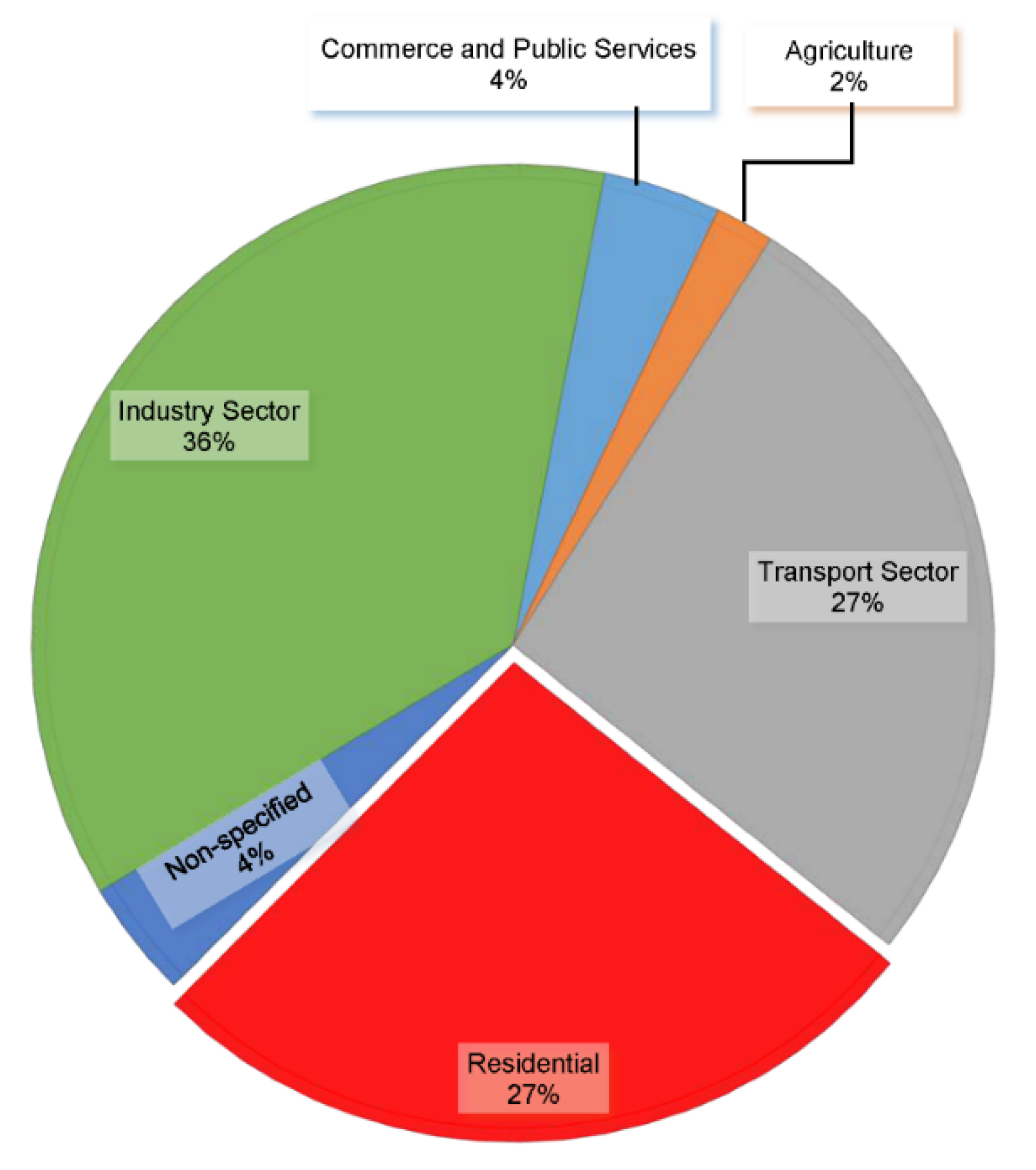
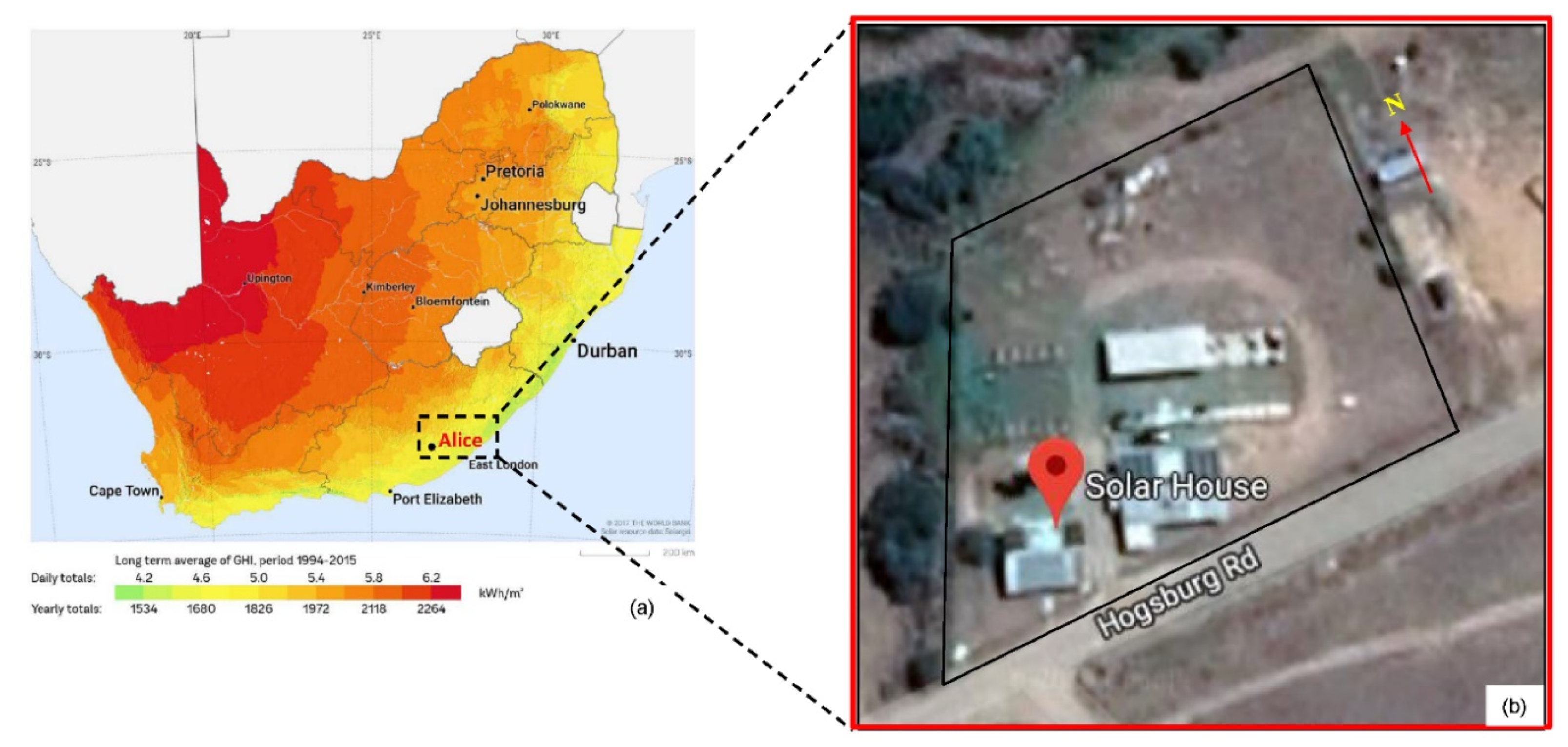
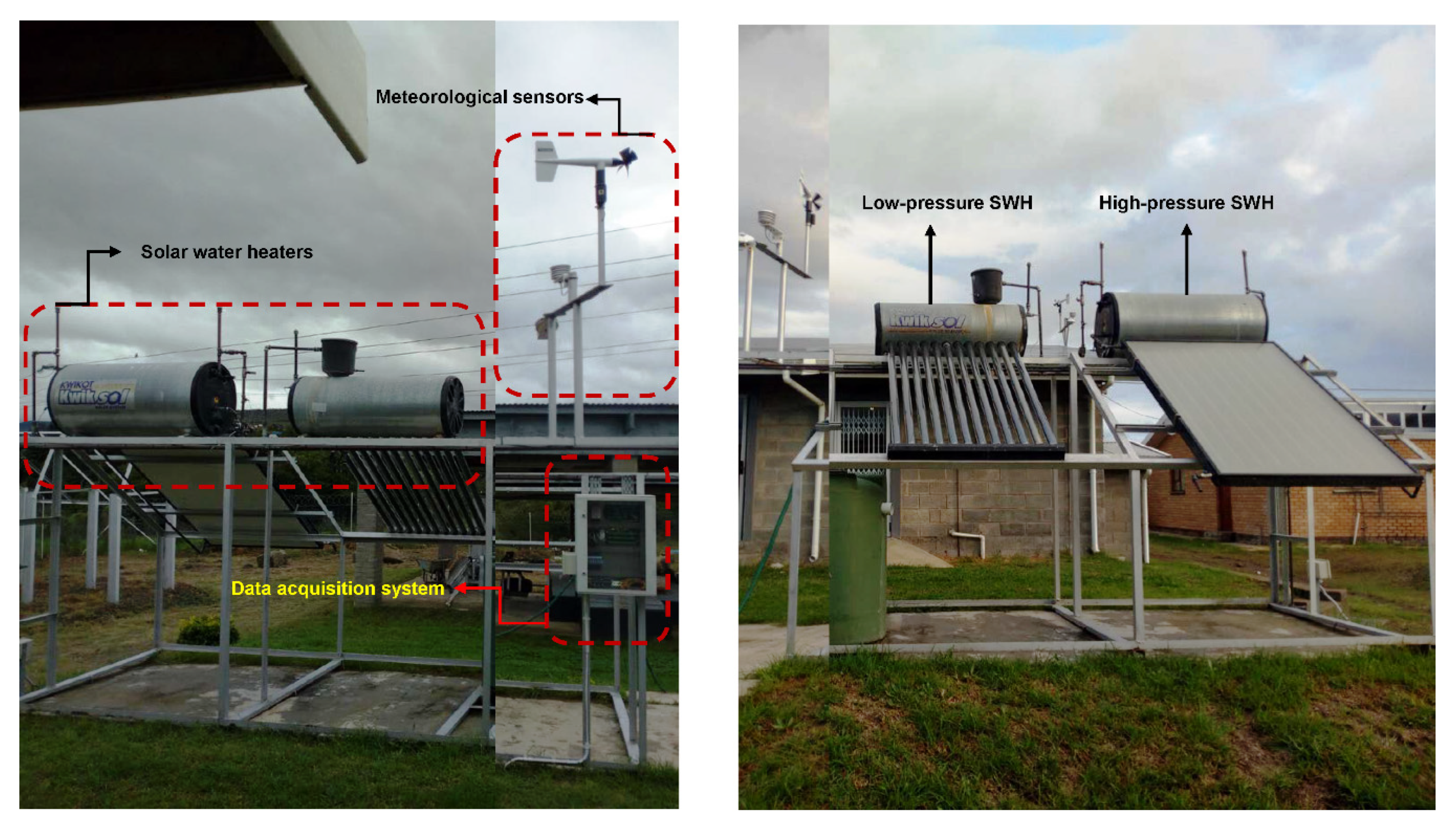
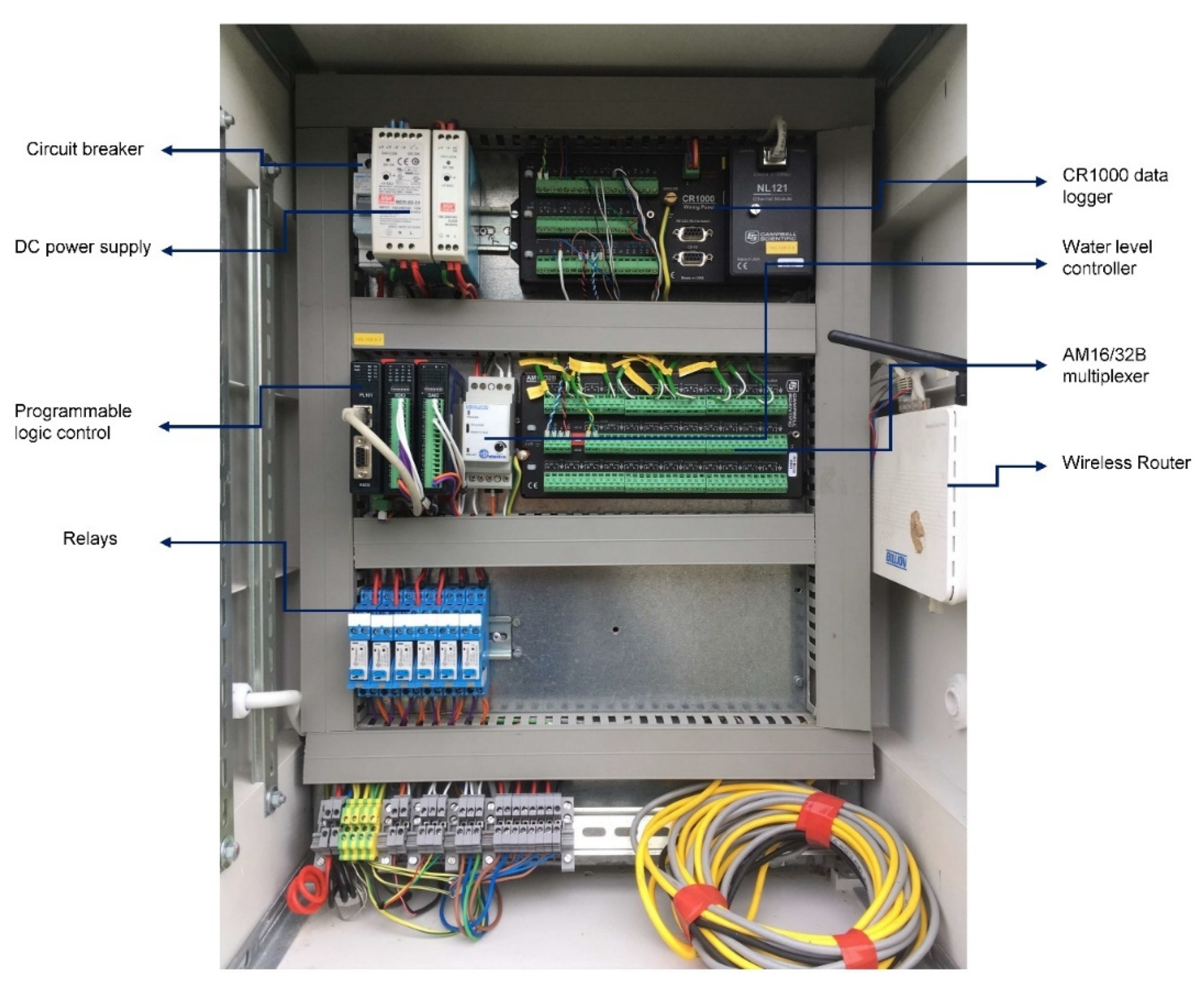
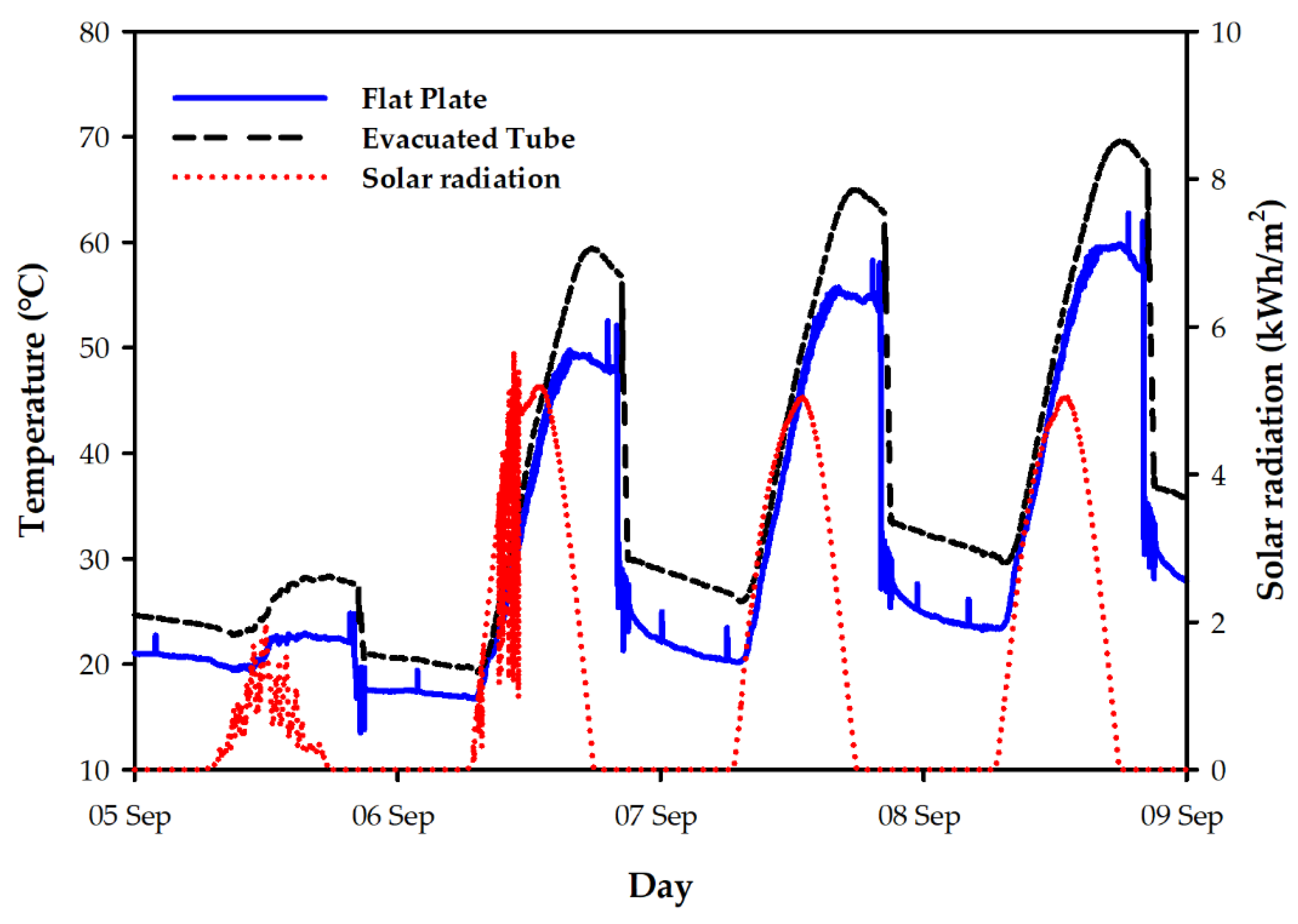
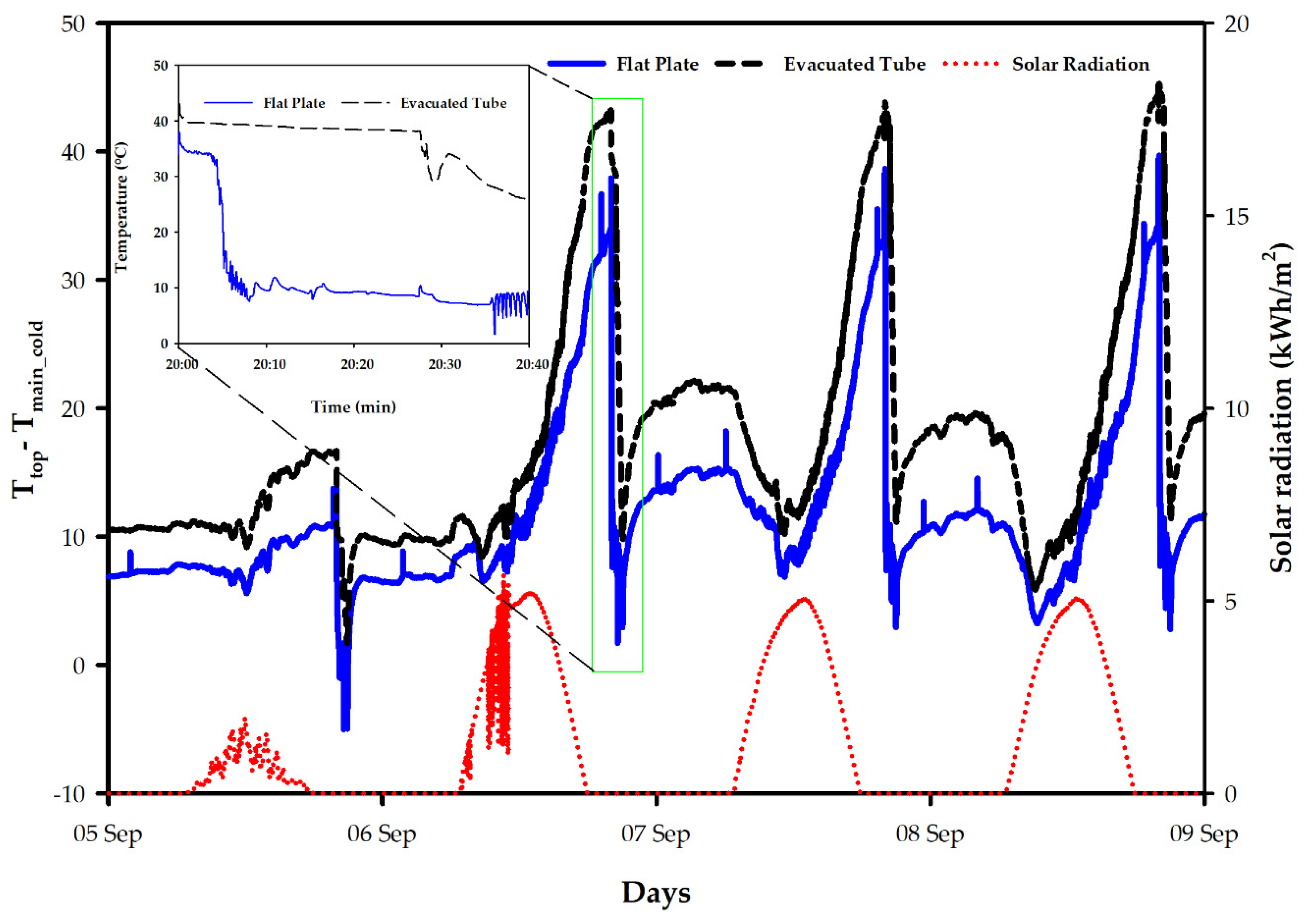
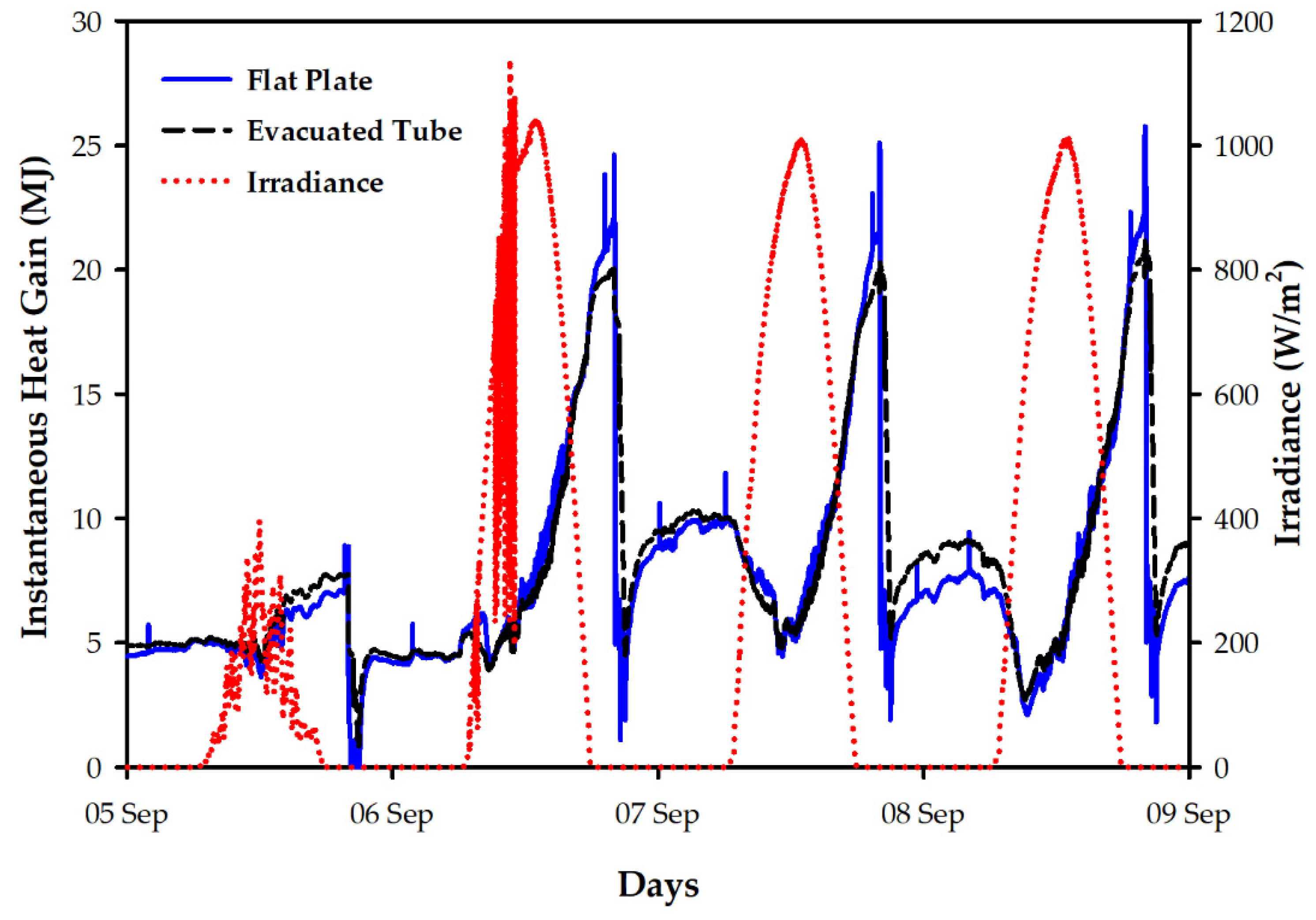
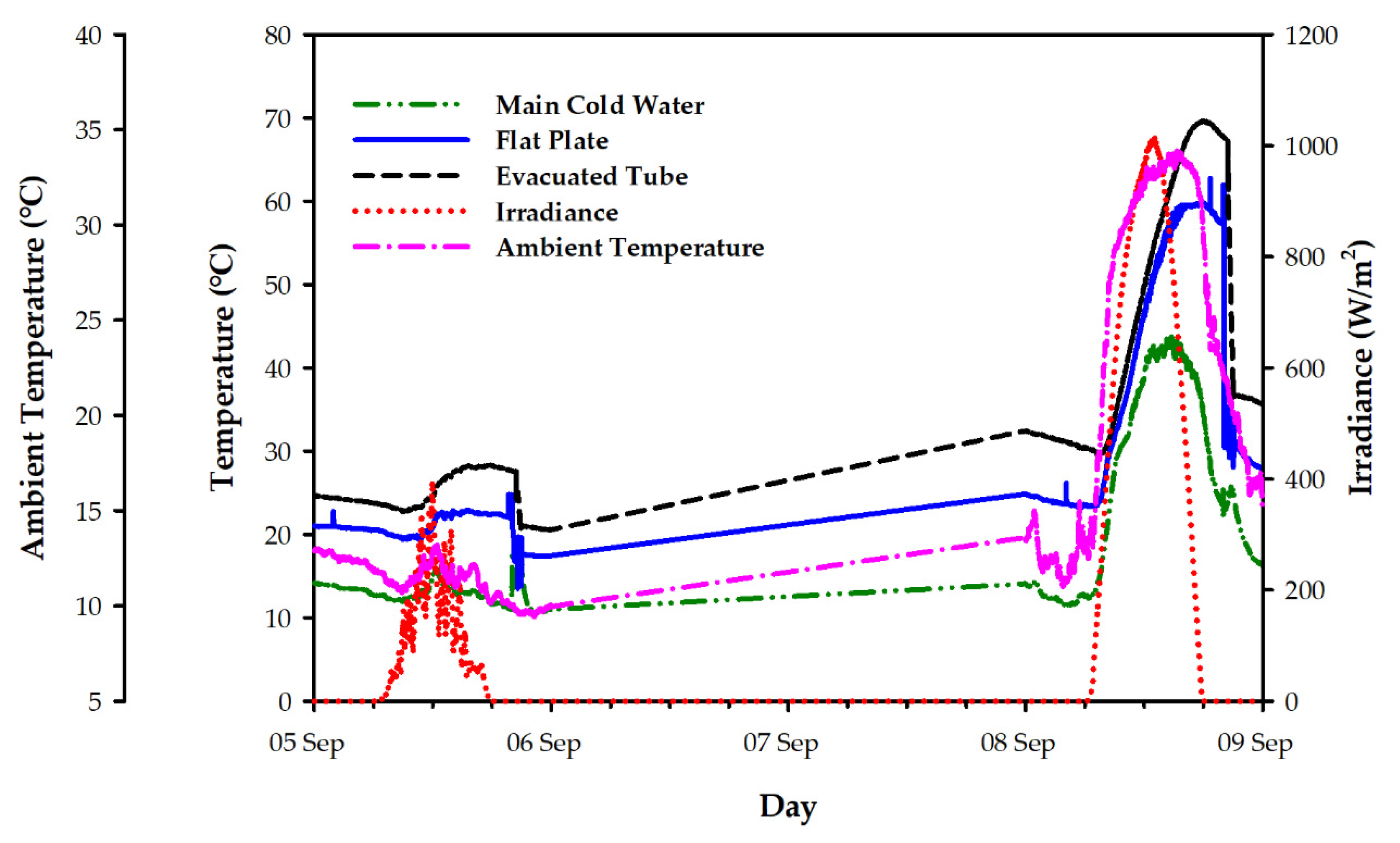
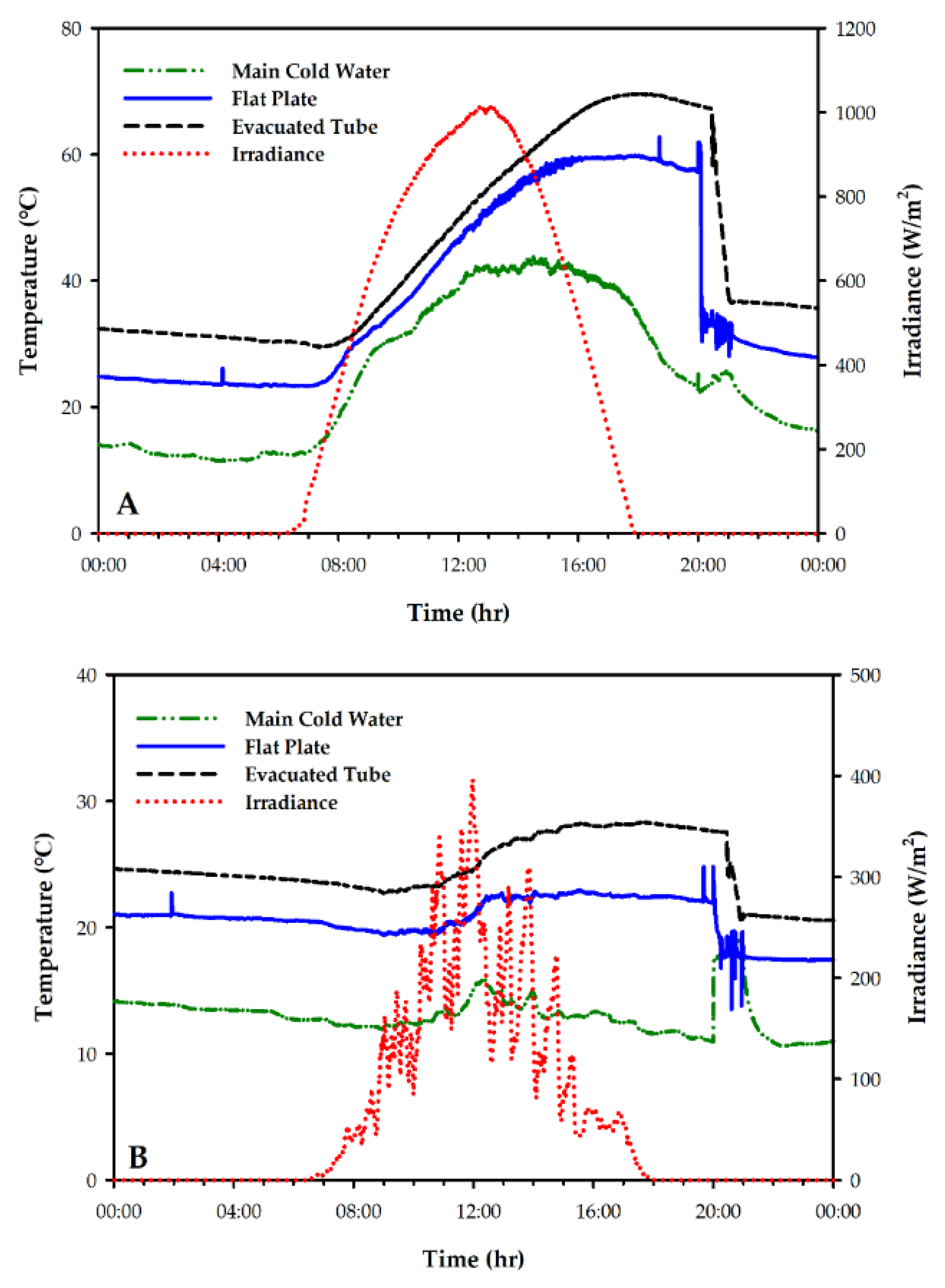
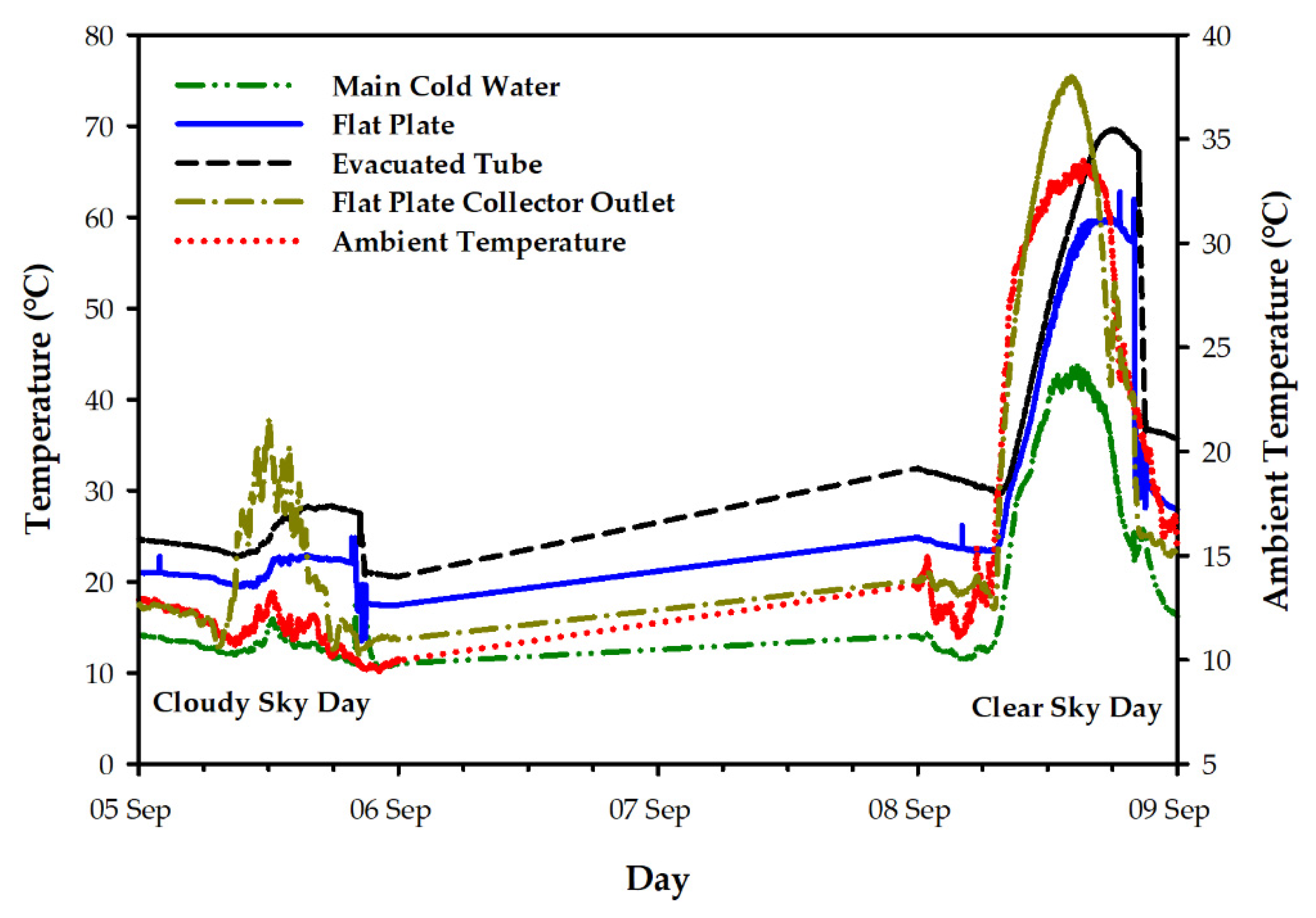
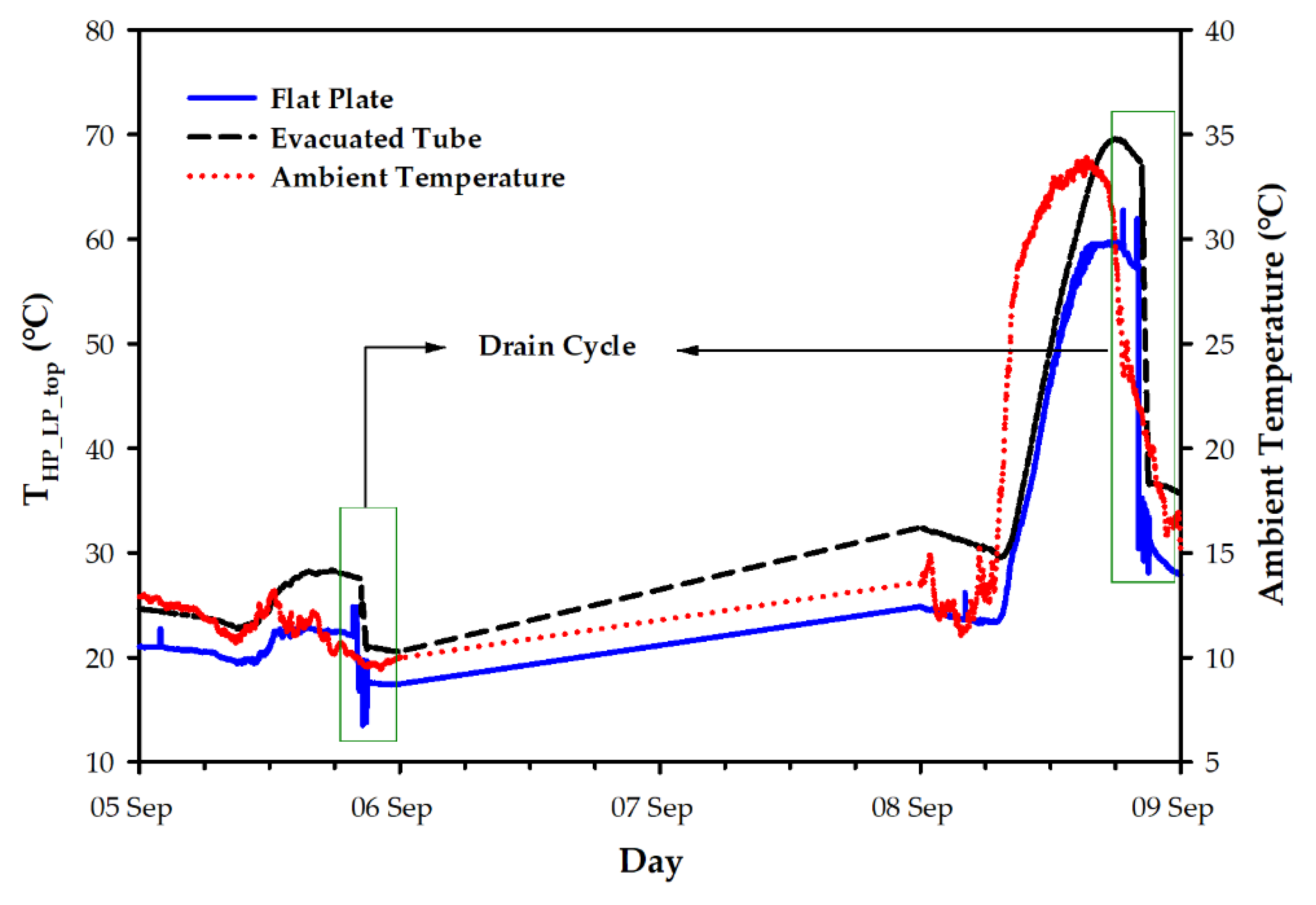
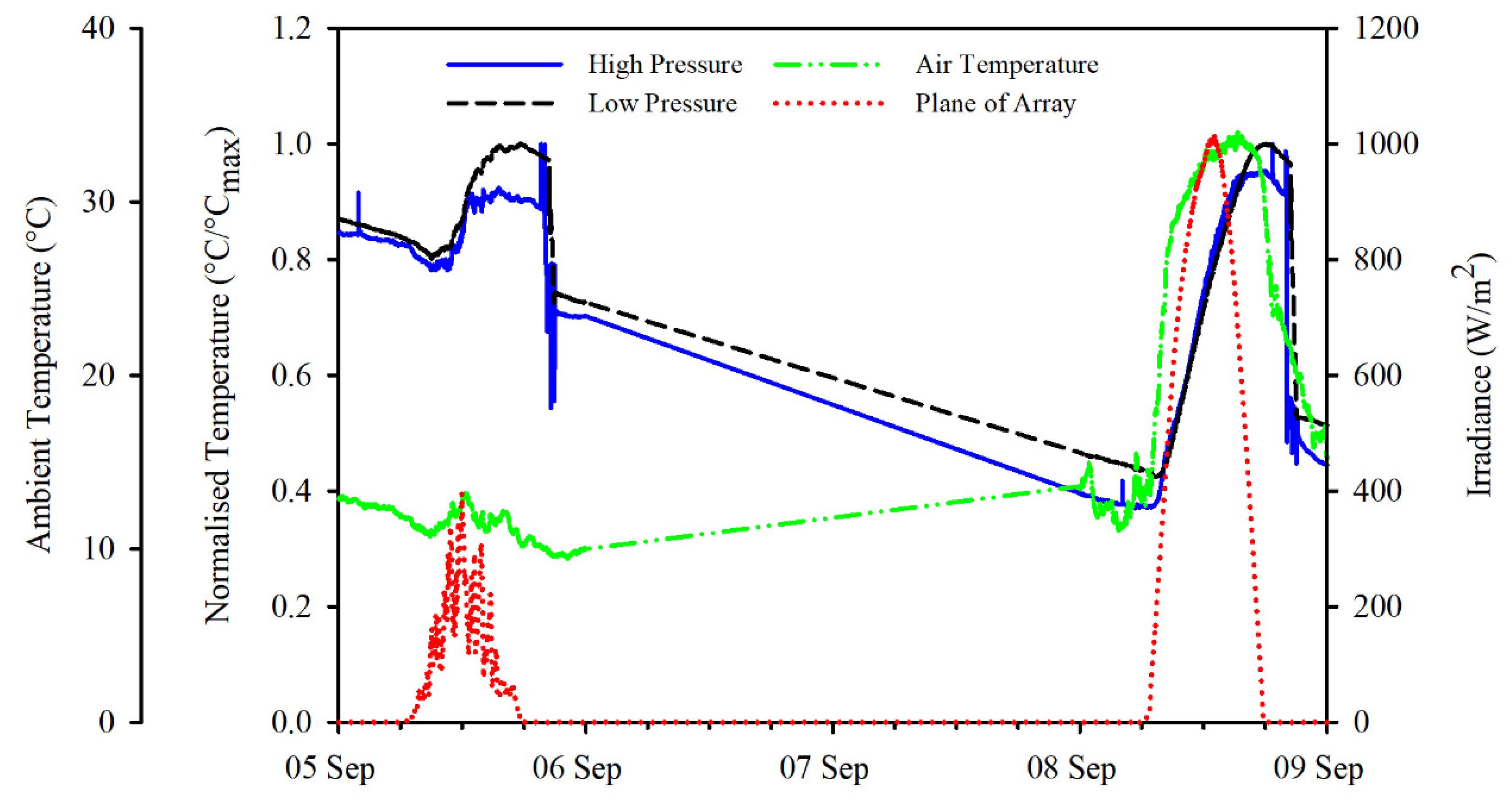
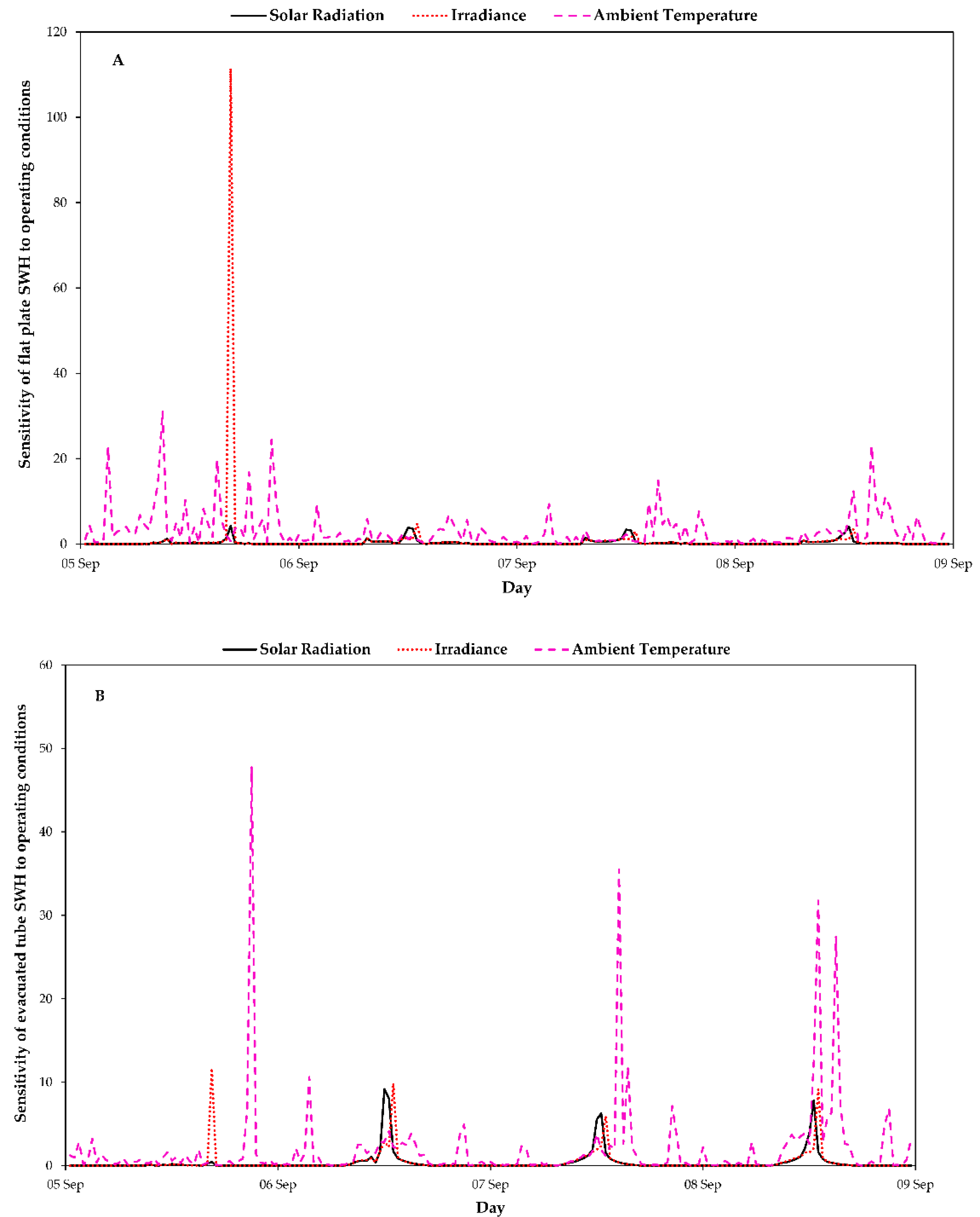
| Technology | Capacity (L) | Number of Plates/Tubes | Area (m2) | Heat Transfer Medium | Heat Loss at Night (%) |
|---|---|---|---|---|---|
| Flat plate collector | 200 | 1 | 2.5 | Water | 12.44 |
| Evacuated tube | 150 | 12 | 2.2 | Water | 16.05 |
| Device Name | Range | Sensor Type | Accuracy/Sensitivity |
|---|---|---|---|
| 41382VC RH/T Probe | 0–100% RH/−50–50 °C | Rotronic Hygromer/100 Ohm Platinum RTD | ±2%/± 0.3 °C |
| KM07 type-K thermocouple | −50–250 °C | Helicoid Propeller | ±1.5 °C ±0.25% |
| CMP10 Kipp & Zonen Pyranometer | 285–2800 nm | Thermopile | 7–14 µV/W/m2 |
| System | (°C) | ($) | (kWh/day) | Annual Saving ($) | Payback Period (Years) |
|---|---|---|---|---|---|
| Flat Plate | 39.69 | 0.144 | 6.97 | 366.34 | 3 |
| Evacuated Tube | 45.68 | 0.144 | 5.23 | 274.89 | 3.8 |
Publisher’s Note: MDPI stays neutral with regard to jurisdictional claims in published maps and institutional affiliations. |
© 2021 by the authors. Licensee MDPI, Basel, Switzerland. This article is an open access article distributed under the terms and conditions of the Creative Commons Attribution (CC BY) license (https://creativecommons.org/licenses/by/4.0/).
Share and Cite
Nwodo, J.C.; Overen, O.K.; Meyer, E.L. Decoupling the Monitoring of Solar Water Heaters and their Usage Profiles. Water 2021, 13, 3186. https://doi.org/10.3390/w13223186
Nwodo JC, Overen OK, Meyer EL. Decoupling the Monitoring of Solar Water Heaters and their Usage Profiles. Water. 2021; 13(22):3186. https://doi.org/10.3390/w13223186
Chicago/Turabian StyleNwodo, Julian C., Ochuko K. Overen, and Edson L. Meyer. 2021. "Decoupling the Monitoring of Solar Water Heaters and their Usage Profiles" Water 13, no. 22: 3186. https://doi.org/10.3390/w13223186
APA StyleNwodo, J. C., Overen, O. K., & Meyer, E. L. (2021). Decoupling the Monitoring of Solar Water Heaters and their Usage Profiles. Water, 13(22), 3186. https://doi.org/10.3390/w13223186








